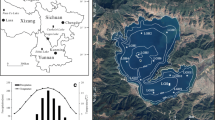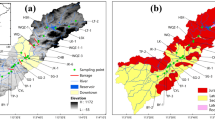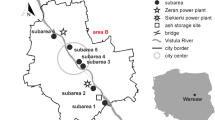Abstract
As the largest industrial city locating in the Northwestern China, Lanzhou has become one of the most seriously polluted cities in the world. In this study, investigations were performed on the magnetic properties, heavy metals and organic matter contents of a total of 23 sediment samples collected from eight selected rivers in the Lanzhou urban area. The results of the study indicate that the magnetic properties of the sediment samples are predominated by low-coercivity magnetite. The river sediments are classified into three types, i.e., downstream polluted, upstream polluted, and less affected, based on the contribution from anthropogenic activities in different segments of the river as indicated by the variation of magnetic mineral concentration parameters. Moreover, a strong linear positive correlation exists among some of the magnetic parameters and organic matter content, heavy metals (Cr, Ni, Pb, Zn, Fe) and total enrichment factor (R) of the bulk deposit samples, which indicates that environmental magnetic technology may be an effective method for distinguishing source apportionment and monitoring river sediment pollution in urban areas.






Similar content being viewed by others
References
Adami G, Barbieri P, Reisenhofer E (2000) An improved index for monitoring metal pollutants in surface sediments. Toxicol Environ Chem 77:189–197
Adamo P, Arienzo M, Imperato M, Naimo D, Nardi G, Stanzione D (2005) Distribution and partition of heavy metals in surface and subsurface sediments of Naples city port. Chemosphere 61:800–809
Alloway BJ (1990) Heavy metals in soils. Halsted Press, USA/Canada, pp 1–371
Beckwith PR, Ellis JB, Revitt DM (1986) Heavy metal and magnetic relationships for urban source sediments. Phys Earth Planet Interior 42:67–75
Bityukova L, Scholger R, Birke M (1999) Magnetic susceptibility as indicator of environmental pollution of soils in Tallinn. Phys Chem Earth 24(9):829–835
Boyle JF (2000) Rapid elemental analysis of sediment samples by isotope source XRF. J Paleolimnol 23:213–221
Charlesworth SM, Lees JA (1997) The use of mineral magnetic measurements in polluted urban lakes and deposited dusts, Coventry, UK. Phys Chem Earth 22:203–206
Dauvalter V, Rognerud S (2001) Heavy metal pollution in sediments of the Pasvik River drainage. Chemosphere 42:9–18
Day R, Fuller M, Schmidt VA (1977) Hysteresis properties of titanomagnetites: grain-size and compositional dependence. Phys Earth and Planet In 13:260–267
Dearing JA (1999) Magnetic susceptibility In “Methods of Environmental Magnetism: A Practical Guide”. London, Quaternary Research Association. Technical Guide No.6, pp 35–62
Dearing JA, Dann RJL, Hay K, Lees JA, Loveland PJ, Maher BA, O’Grady K (1996) Frequency-dependent susceptibility measurements of environmental materials. Geophys J Int 124:228–240
Dearing JA, Bird PM, Dann RJL, Benjamin SF (1997) Secondary ferrimagnetic minerals in Welsh soils: a comparison of mineral magnetic detection methods and implications for mineral formation. Geophys J Int 130:727–736
Desentfant F, Petrovský E, Rochette P (2004) Magnetic signature of industrial pollution of stream sediments and correlation with heavy metals: case study from South France. Water Air Soil Poll 152:297–312
Dunlop DJ (2002) Theory and application of the Day plot (Mrs/Ms versus Hcr/Hc)1. Theoretical curves and test using titanomagnetite data. J Geophys Res 107(B3). doi:10.1029/2001JB000486
Evans ME, Heller F (2003) Environmental magnetism-principles and applications of environmagnetism. Academic Press, London, pp 1–288
Farkas A, Erratico C, Vigano L (2007) Assessment of the environmental significance of heavy metal pollution in surficial sediments of the River Po. Chemosphere 68:761–768
Gautam P, Blaha U, Appel E (2005a) Magnetic susceptibility of dust-loaded leaves as a proxy of traffic-related heavy metal pollution in Kathmandu city, Nepal. Atmos Environ 39:2201–2211
Gautam P, Blaha U, Appel E (2005b) Integration of magnetism and heavy metal chemistry of soils to quantify the environmental pollution in Kathmandu, Nepal. Isl Arc 14:424–435
Geogeaud VM, Rochette P, Ambrosi JP, Vandamme D, Williams D (1997) Relationship between heavy metals and magnetic properties in a large polluted catchment: the Etang de Berre (south of France). Phys Chem Earth 22:211–214
Glikson M, Rutherford S, Simpson RW, Mitchell CA, Yago A (1995) Microscopic and submicron components of atmospheric particulate matter during high asthma periods in Brisbane, Queensland, Australia. Atmos Environ 29:549–562
Hakanson L (1992) Sediment variability. IN: sediment toxicity assessment. Lewis Publishers, Boca Raton, pp 19–35
Kapička A, Jordanova N, Petrovský E, Podrázský V (2003) Magnetic study of weakly contaminated forest soils. Water Air Soil Poll 148:31–44
Katahira K, Ishitake M, Moriwaki H, Yamamoto O, Fujita T, Yamazaki H, Yoshikawa S (2009) Statistical analysis of metal concentrations in a sediment core to reveal influences of human activities on atmospheric Environment for 200 years. Water Air Soil Poll 204:215–225
King J, Banerjee SK, Marvin J, Özdemir Ö (1982) A comparison of different magnetic methods for determining the relative grain size of magnetite in natural materials. Earth Planet Sci Lett 59:404–419
Kukier U, Ishak CF, Sumner ME, Miller WP (2003) Composition and element solubility of magnetic and non-magnetic fly ash fractions. Environ Pollut 123:255–266
Maher BA (1986) Characterisation of soil by mineral magnetic measurement. Phys Earth Planet Interior 42:76–92
Maher BA (1988) Magnetic properties of some synthetic sub-micron magnetites. Geophys J 94:83–96
Matzka J, Maher BA (1999) Magnetic biomonitoring of roadside tree leaves: identification of spatial and temporal variations in vehicle-derived particles. Atmos Environ 33:4565–4569
Muxworthy AR, Schmidbauer E, Petersen N (2002) Magnetic properties and Mössbauer spectra of urban atmospheric particulate matter: a case study from Munich, Germany. Geophys J Int 150:558–570
Oldfield F, Richardson N (1990) Lake sediment magnetism and atmospheric deposition. Philos T R Soc B327:325–330
Oldfield F, Yu LZ (1994) The influence of particle size variations on the magnetic properties of sediments from the north-eastern Irish Sea. Sedimentology 41:1093–1108
Peters C, Thompson R (1998) Magnetic identification of selected natural iron oxides and sulphides. J Magn Magn Mater 183:365–374
Salomons W, Stigliani WM (1995) Biogeodynamics of pollutants in soils and sediments—risk assessment of delayed and non-linear responses. Springer, Berlin, pp 1–352
Shilton VF, Booth CA, Smith JP, Giess P, Mitchell DJ, Williams CD (2005) Magnetic properties of urban street dust and their relationship with organic matter content in the West Midlands, UK. Atmos Environ 39:3651–3659
Siegel FR (2002) Environmental geochemistry of potentially toxic metals. Springer, Berlin/Heidelberg/New York, pp 1–230
Sinha R, Bhattacharjee PS, Sangode SJ, Gibling MR, Tandon SK, Jain M, Godfrey-Smith D (2007) Valley and interfluve sediments in the Southern Ganga plains, India: exploring facies and magnetic signatures. Sediment Geol 201:386–411
Stroganova MN, Myagkova AD, Prikofeeva TV, Skvortsova IN (1998) Soils of Moscow and urban environment. Russian Federation Press/Lomonosov Moscow State University, Moscow, pp 71–121
Thompson R, Oldfield F (1986) Environmental Magnetism. Allen & Unwin, London, pp 1–227
Tiller KG (1992) Urban soil contamination in Australia. Aust J Soil Res 30:937–957
Wang G, Xia DS, Liu XM, Chen FH, Yang LP, Wei HT (2008) Spatial and temporal variation in magnetic properties of street dust in an industrial city of Northwest China. Chin Sci Bull 53(12):1913–1923
Wang B, Xia DS, Yu Y, Jia J, Tian SL, Liu XB (2011a) Use of environmental magnetism to monitor pollution in the river sediment of an urban area. Huan jing ke xue xue bao 31(9):1979–1991 (in Chinese)
Wang B, Zhao S, Xia DS, Yu Y, Tian SL, Jia J, Jiang XR (2011b) Characteristics of heavy metal elements and their relationship with magnetic properties of river sediment from urban area in Lanzhou. Huan jing ke xue 32(5):1430–1440 (in Chinese)
Xia DS, Yu Y, Tian SL, Wang B, Wang L (2011) Use of environmental magnetic techniques to monitor urban pollution origins in Lanzhou, Northwest China. Environ Earth Sci 64:1943–1949
Xie SJ, Dearing JA, Bloemendal J, Boyle JF (1999) Association between the organic matter content and magnetic properties in street dust, Liverpool, UK. Sci Total Environ 241:205–214
Xie SJ, Boyle JF, Bloemendal J, Morse AP, Dering JA (2001) Association between magnetic properties and element concentrations of Liverpool street dust and its implications. J Appl Geophys 48:83–92
Yang T, Liu QS, Chan LS, Liu ZD (2007) Magnetic signature of heavy metals pollution of sediments: case study from the East Lake in Wuhan, China. Environ Geol 52:1639–1650
Acknowledgments
This research was supported by the National Natural Science Foundation of China (No. 41071125; 40871090) and 100 Talents Program of The Chinese Academy of Sciences (No. O827631002).
Author information
Authors and Affiliations
Corresponding author
Rights and permissions
About this article
Cite this article
Wang, B., Xia, D.S., Yu, Y. et al. Magnetic properties of river sediments and their relationship with heavy metals and organic matter in the urban area in Lanzhou, China. Environ Earth Sci 70, 605–614 (2013). https://doi.org/10.1007/s12665-012-2144-7
Received:
Accepted:
Published:
Issue Date:
DOI: https://doi.org/10.1007/s12665-012-2144-7




